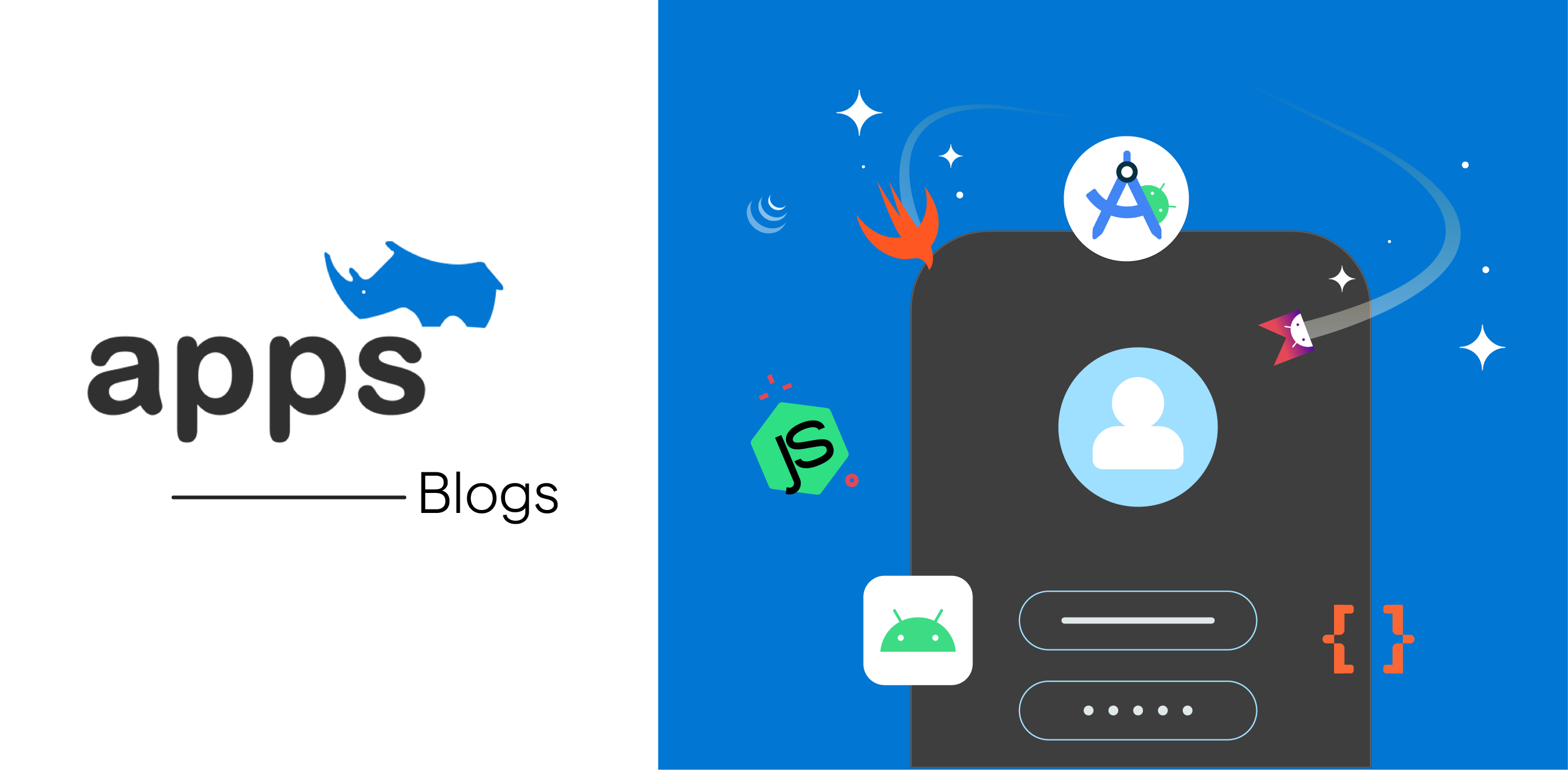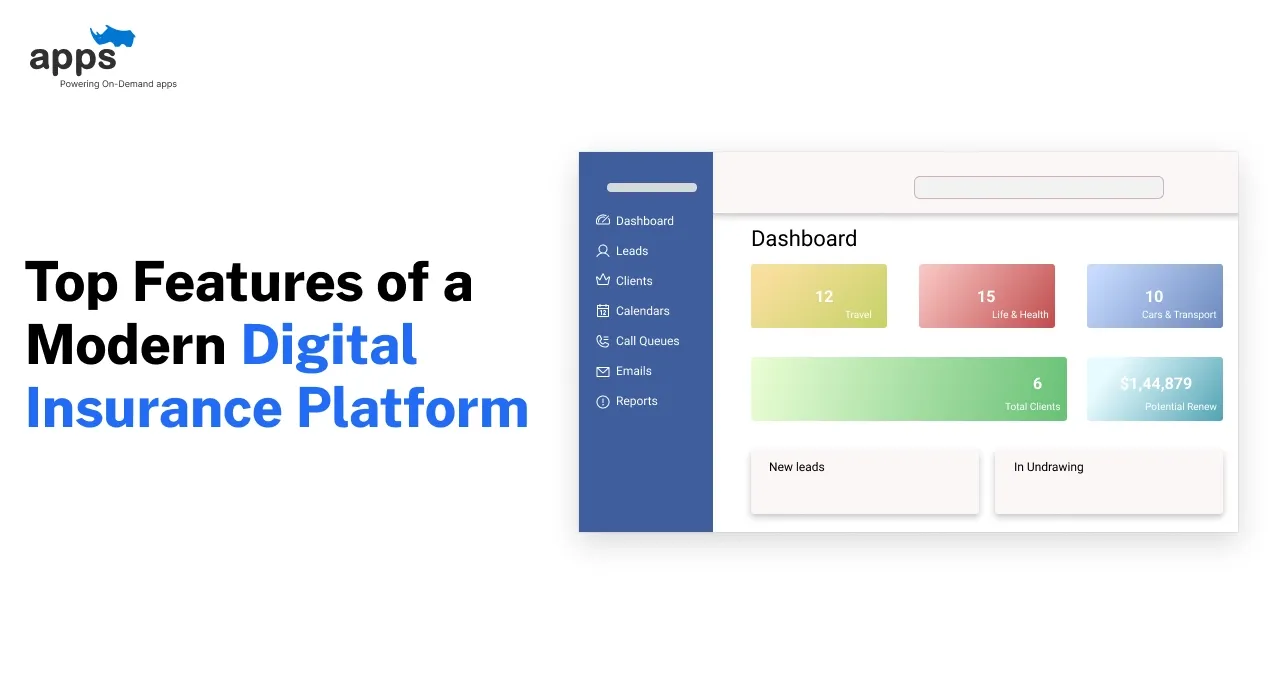- Introduction
- What is Shipment Tracking Software?
- Key Features of Shipment Tracking Software
- How Shipment Tracking Software Works
- Types of Shipment Tracking Software
- Benefits of Shipment Tracking Software
- Common Challenges and Limitations of Shipment Tracking Software
- Quick Reference: Common Limitations & Practical Solutions
- How to Choose the Right Shipment Tracking Software
- Top Shipment Tracking Software Options in 2025
- Future of Shipment Tracking
- Final Thoughts: Why Shipment Tracking Software Is No Longer Optional
- Frequently Asked Questions (FAQs)
Table of Contents
What is Shipment Tracking Software? Everything You Need To Know
Introduction
Shipment tracking has become a cornerstone of modern logistics and e-commerce. Today’s consumers demand transparency — 87% prefer real-time tracking over periodic updates.
On the business side, the scale is staggering. In 2020, over 20 billion parcels were shipped in the U.S., generating $71 billion in revenue (Source: Pitney Bowes Parcel Shipping Index).
Traditionally, tracking required entering a number on a carrier’s website.
Now, shipment tracking software automates and consolidates this process across multiple carriers and shipping modes. It provides real-time location updates, delivery estimates, and transit logs—all in one interface.
This improves customer satisfaction, reduces support queries, and helps businesses manage shipping at scale. Adopting robust delivery tracking software is strategic for brands aiming to compete in a fast-paced delivery economy.
What is Shipment Tracking Software?
Shipment tracking software (also known as delivery tracking software) is a digital tool (usually a cloud-based platform or app) that enables businesses to monitor the status and location of shipments from dispatch to delivery.
It simply answers the question: “Where is my package now, and when will it arrive?”
This software provides end-to-end visibility by pulling data from various sources – carrier scans, GPS devices, barcode/RFID scans, and more into one unified dashboard.
Companies use it to track parcels, freight, or orders in real time across different carriers and transportation modes.
- Key capabilities of shipment tracking software include showing a shipment’s current location on a map, updating its status at each checkpoint, and sending alerts for important events (like out-for-delivery or delays).
- Advanced systems use GPS and RFID to provide live updates on shipment location and condition.
- Users (both business staff and customers) can access tracking information through web portals, mobile apps, or even integrations in their existing systems.
By consolidating all this information, this delivery tracking software helps businesses reduce lost packages and delays, proactively handle exceptions, and keep customers informed.
It’s widely used in e-commerce, retail, manufacturing, and logistics to improve on-time delivery and customer satisfaction.
Key Features of Shipment Tracking Software
Effective shipment tracking software comes packed with features that streamline logistics, reduce delivery errors, and ensure customer satisfaction.
From real-time visibility to branded experiences, these tools help businesses optimize every aspect of the delivery cycle.
Below are the essential features every robust shipment tracking software should offer.
A) Real-Time GPS Tracking
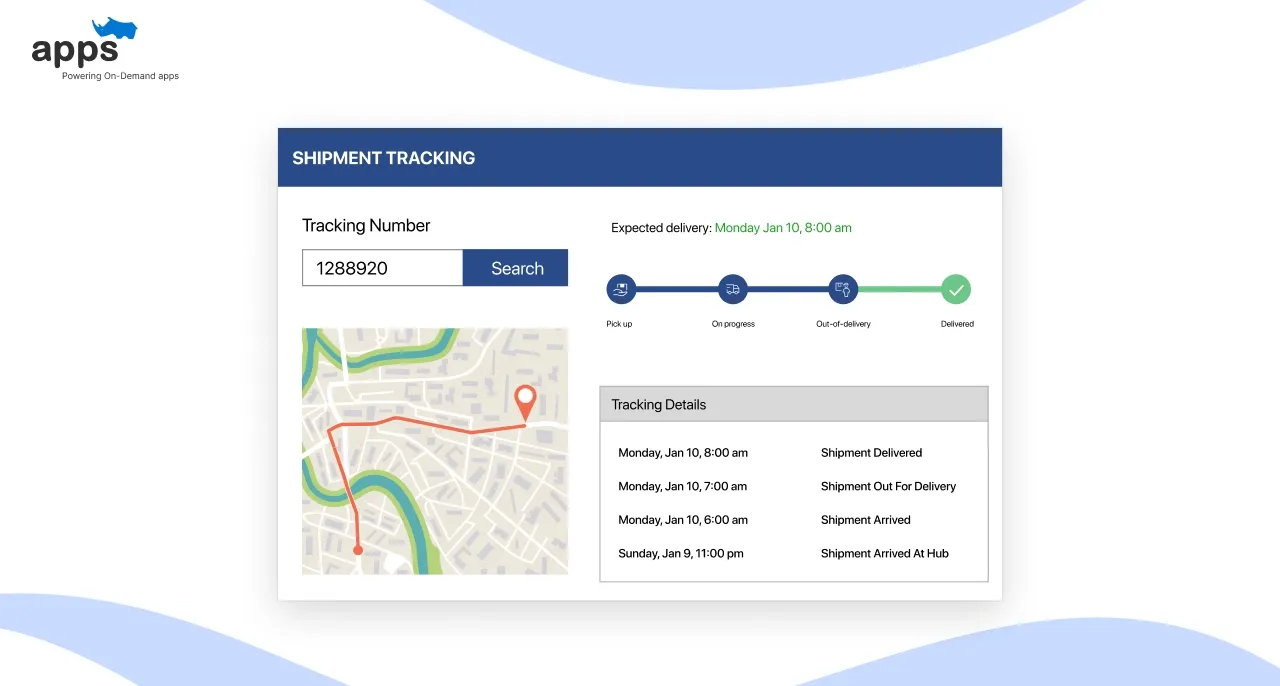
Shipment tracking software provides real-time GPS tracking, allowing logistics managers and customers to view the live location of packages on a map. This reduces uncertainty and improves planning on both ends.
Live tracking is beneficial during high-volume shipping seasons, where visibility into transit delays can help reroute resources and avoid customer dissatisfaction.
B) Status Updates & Notifications
Shipment tracking software sends automated alerts at each milestone, pickup, transit, out for delivery, and final delivery. These can be delivered via email, SMS, or push notifications.
Proactive updates eliminate the need for “Where is my order?” queries and build trust through transparency. Businesses can also customize notification rules based on customer type or shipping method.
C) Branded Tracking Pages
Many shipment tracking software platforms support branded tracking portals. These let businesses show tracking data on a custom webpage with their logo, colors, and messaging.
Rather than redirecting users to a third-party carrier, branded pages keep customers on-site and even open opportunities for promotions or upsells.
D) Multi-Carrier Integration
Top shipment tracking software integrates with hundreds of global and regional carriers like FedEx, DHL, USPS, and UPS. This eliminates the need to juggle between multiple platforms.
The software normalizes various carrier status codes into one format, ensuring consistency and easier management for operations teams.
E) Analytics and Reporting
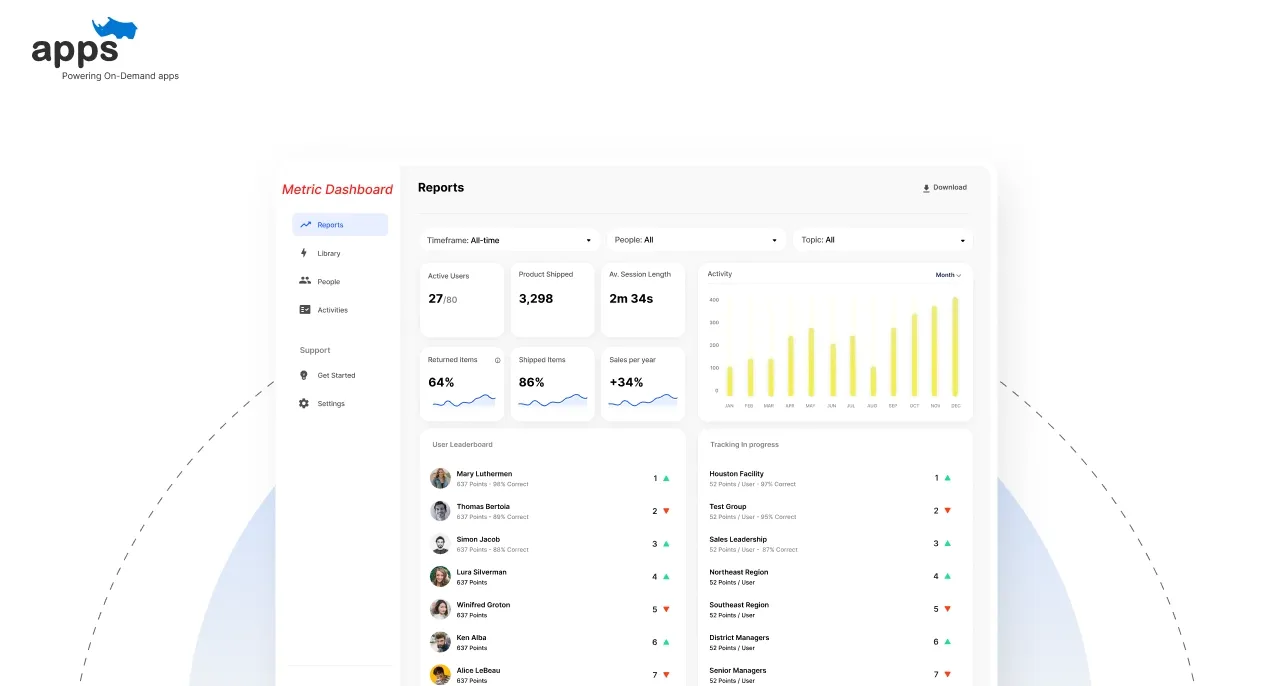
Analytics dashboards help businesses monitor performance indicators such as average transit time, on-time delivery rates, and carrier delay frequency.
Shipment tracking software turns tracking data into actionable insights that drive better decision-making and continuous improvement.
F) Exception Management
When delays, holds, or other disruptions occur, the software flags them as exceptions. This enables customer service and logistics teams to respond quickly.
By catching these issues early, shipment tracking software minimizes failed deliveries and enhances customer satisfaction.
G) Mobile Accessibility
Most shipment tracking software solutions include mobile apps or responsive web portals. These allow delivery agents to scan packages and update status in real time.
Customers also benefit from the ability to check their order status anytime, anywhere. Mobile accessibility enhances the convenience and responsiveness of the entire delivery process.
H) Proof of Delivery (POD)
Electronic proof of delivery, including signatures or photos, is captured during drop-off. This closes the loop on fulfillment.
By confirming successful handover, shipment tracking software helps resolve disputes quickly and ensures accountability.
Together, these features make shipment tracking software a location tool and a full-suite solution for delivery visibility, efficiency, and customer engagement.
How Shipment Tracking Software Works
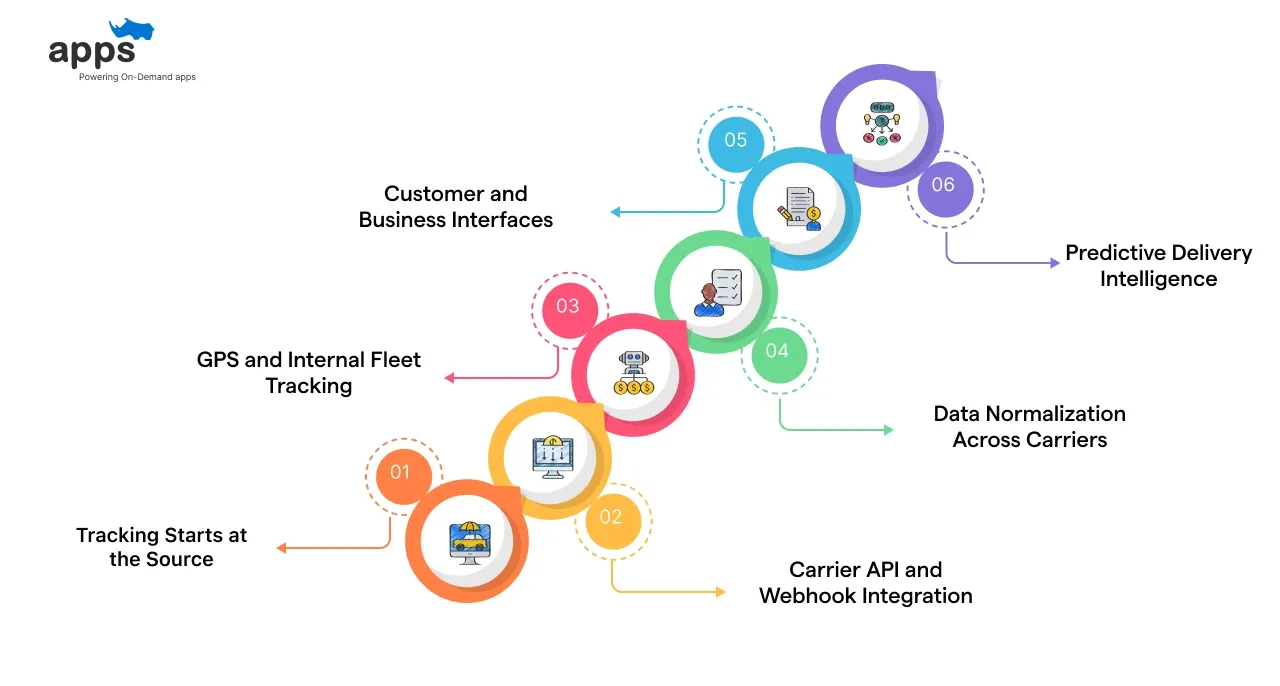
Modern shipment tracking software acts as the command center of delivery visibility.
It collects and standardizes data across multiple systems—carrier APIs, GPS signals, and scan events to provide a unified, real-time shipment view.
Let’s walk through how this technology works at each journey step.
Step 1: Tracking Starts at the Source
Each shipment begins with a unique tracking identifier—typically a barcode, QR code, or RFID tag. This identifier is assigned when the package is labeled and packed at the warehouse.
The software then tracks that ID through multiple scan points, as given below.
- At the warehouse departure
- In regional sorting hubs
- On local delivery vehicles
Each scan is automatically recorded and synced with the shipment tracking software, making a continuous digital trail visible to the sender and receiver.
Step 2: Carrier API and Webhook Integration
Most shipment tracking software connects directly to major carrier systems through secure APIs to ensure real-time tracking.
These APIs allow automatic retrieval of the following data.
- Location updates
- Delivery status changes
- Time-stamped scan events
Some advanced carriers also use webhooks—tools that instantly push updates to the software when a scan occurs. This minimizes data lag and improves delivery transparency.
Step 3: GPS and Internal Fleet Tracking
The software uses multiple tools to maintain real-time visibility for businesses managing their own delivery fleets.
The tools are given below.
- Integrated GPS devices in delivery vehicles
- Mobile apps for delivery drivers
- Route planning and optimization platforms
This combination ensures complete control over vehicle locations and ETAs, helping companies improve routing efficiency, reduce delays, and enhance customer trust.
Step 4: Data Normalization Across Carriers
Different carriers often use inconsistent status labels—one might say “In Transit” while another uses “Shipped.”
To avoid confusion, shipment tracking software applies data normalization, which converts the following.
- Varied carrier statuses
- Event labels
- Location formats
Into a standardized system that ensures uniformity across all tracked deliveries, making it easier for teams and customers to interpret status updates.
Step 5: Customer and Business Interfaces
When users check on their deliveries, shipment tracking software provides a simplified, branded view.
They are as follows.
- Live package location
- Estimated delivery date and time
- Any shipping delays or issues
For internal teams, dashboard views support real-time operations monitoring and customer service management at scale.
Step 6: Predictive Delivery Intelligence
Advanced shipment tracking software platforms go beyond static updates.
They use predictive analytics to anticipate delivery outcomes by evaluating.
- Historical carrier performance
- Live weather and traffic conditions
- Regional delivery benchmarks
These insights allow the software to forecast potential delays, update ETAs proactively, and trigger alerts to keep businesses and customers informed.
In Summary:
"Shipment tracking software transforms logistics data into real-time visibility, intelligent alerts, and customer confidence."
By fusing data from scans, GPS, APIs, and predictive analytics, the software ensures every shipment is traceable, transparent, and under control—empowering businesses and buyers at every step.
Types of Shipment Tracking Software
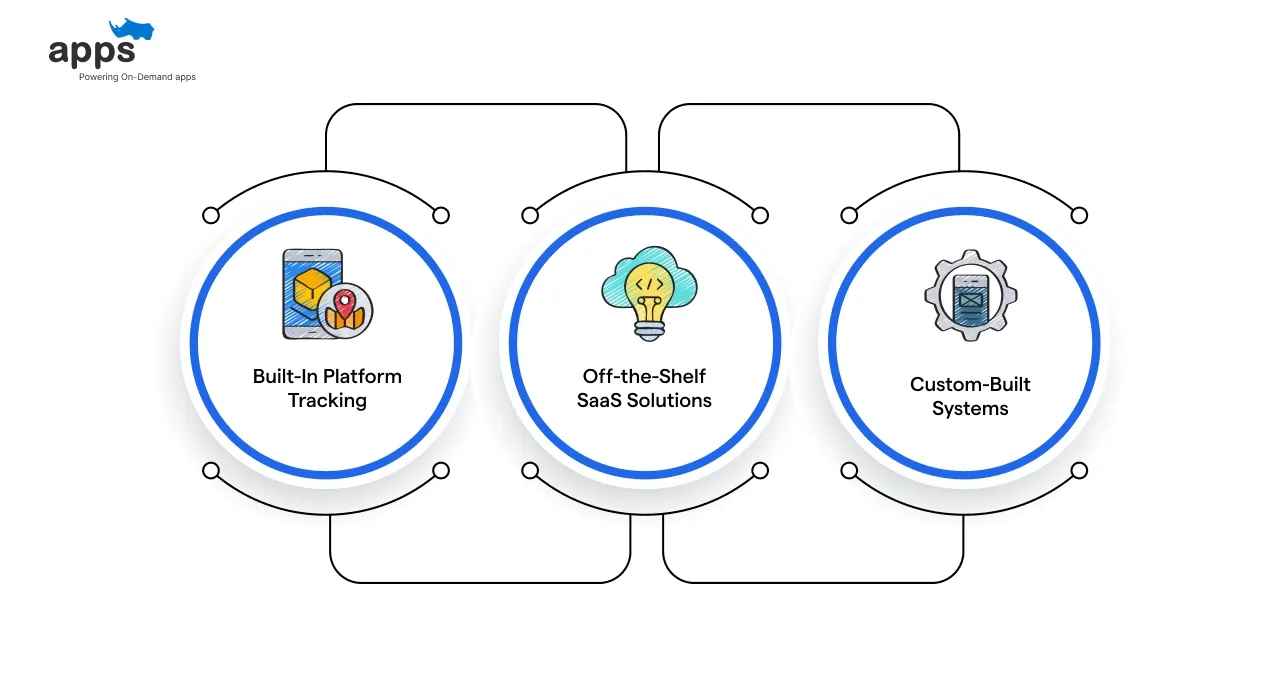
Not all shipment tracking software is created equal. The best fit depends on your business size, shipping volume, technical needs, and budget.
Below are the three main types of tracking solutions available today.
A) Built-In Platform Tracking
This type is often bundled with e-commerce platforms or shipping tools. Examples include Shopify’s native order tracking or tracking dashboards inside seller marketplaces like Amazon or Etsy.
Features Included:
- Free or low-cost, making them ideal for startups and small businesses with minimal delivery needs.
- Easy to use and configure, often requiring just a few steps to activate on your store backend.
- Limited to supported carriers or marketplaces, which can restrict flexibility and broader logistics integration.
However, they may lack advanced features like multi-carrier support, analytics dashboards, or real-time exception alerts. As a result, they’re best suited for small businesses with low shipping complexity.
B) Off-the-Shelf SaaS Solutions
These are third-party shipment tracking software platforms offered on a subscription basis. Examples include AfterShip, Route, and Narvar.
Features Included:
- Multi-carrier tracking across hundreds of carriers, consolidating all shipment data into a single dashboard.
- Customizable branded tracking pages that enhance customer experience and reinforce company identity.
- Automated alerts, analytics, and CRM integrations to support marketing, support, and logistics operations.
They provide a good balance of features and affordability but follow a standardized product model. This means businesses must adapt slightly to the way the tool operates.
C) Custom-Built Systems
Larger enterprises or businesses with particular needs may opt for a custom delivery tracking software solution. This involves developing an in-house system or outsourcing the build to developers or logistics software vendors.
Features Included:
- Complete control over user experience and data flows, allowing the business to set up every detail its way.
- Tight integration with existing ERP, WMS, or CRM systems for smoother operations and data sharing.
- Unlimited customization and future scalability, which allows for long-term innovation and optimization.
The downside? High upfront cost, longer development time, and ongoing maintenance. This path is typically chosen when off-the-shelf tools cannot meet unique operational demands.
Choosing the Right Type
Smaller businesses often start with built-in tools or SaaS platforms for easy use and quick deployment. Enterprises dealing with massive volumes or custom workflows may justify the investment in a tailored solution.
The right shipment tracking software balances features, flexibility, and cost, delivering immediate value and long-term scalability.
Benefits of Shipment Tracking Software
Adopting modern shipment tracking software is no longer just a logistics upgrade—it’s a competitive advantage. Whether a startup or a global enterprise, the right delivery tracking software can transform your operations, customer service, and overall brand value.
Below, we explore how this technology benefits both businesses and their customers.
A) Business Benefits of Shipment Tracking Software
Shipment tracking software delivers measurable value across cost, efficiency, and visibility. It helps logistics teams move from reactive to proactive operations while keeping customers informed and satisfied.
1. Improved Operational Efficiency
Shipment tracking software gives operations teams real-time visibility across the entire delivery chain. Instead of manually chasing updates, businesses can act on accurate data to streamline dispatches and avoid costly delays.
- Enables dynamic rerouting and faster resolution of shipping disruptions
- Improves warehouse-to-door fulfillment timelines and reduces idle inventory
- According to Forrester, real-time tracking can improve efficiency by up to 20% and significantly enhance last-mile delivery performance.
2. Reduced Customer Service Workload
With delivery tracking software, customers have self-service access to tracking data. This reduces dependency on support teams and improves the overall post-purchase experience.
- Fewer inbound queries like “Where is my order?”
- Support agents can focus on high-priority cases rather than repetitive tracking requests.
- Businesses using real-time delivery tracking software report up to 50% fewer support queries (Source: Iplocation).
3. Cost Control and Shipping Accuracy
Shipment tracking software helps reduce missed deliveries, duplicate shipments, and excessive last-mile costs. It also improves route planning, which can lower logistics expenses over time.
- Real-time data cuts down failed delivery attempts.
- Better carrier insights help negotiate more innovative shipping contracts
- Avoid costly reshipments caused by lost or delayed parcels
4. Enhanced Customer Loyalty and Experience
Brands use delivery tracking software to keep customers informed throughout the delivery lifecycle. This level of communication builds trust and directly impacts retention.
- Real-time updates create a transparent post-purchase journey
- Fewer surprises mean fewer negative reviews or refund requests
- Retailers offering faster delivery with real-time tracking saw an 8.9% lift in repeat purchases (Source: SDC).
5. Smarter Data-Driven Logistics
The analytics dashboards built into most shipment tracking software platforms give businesses powerful insights into shipping performance and customer behavior.
- Monitor KPIs like transit time, delay frequency, and carrier reliability
- Adjust logistics strategies using accurate data, not guesswork
- Spot trends and underperforming carriers before they impact CX
B) Customer Benefits of Delivery Tracking Software
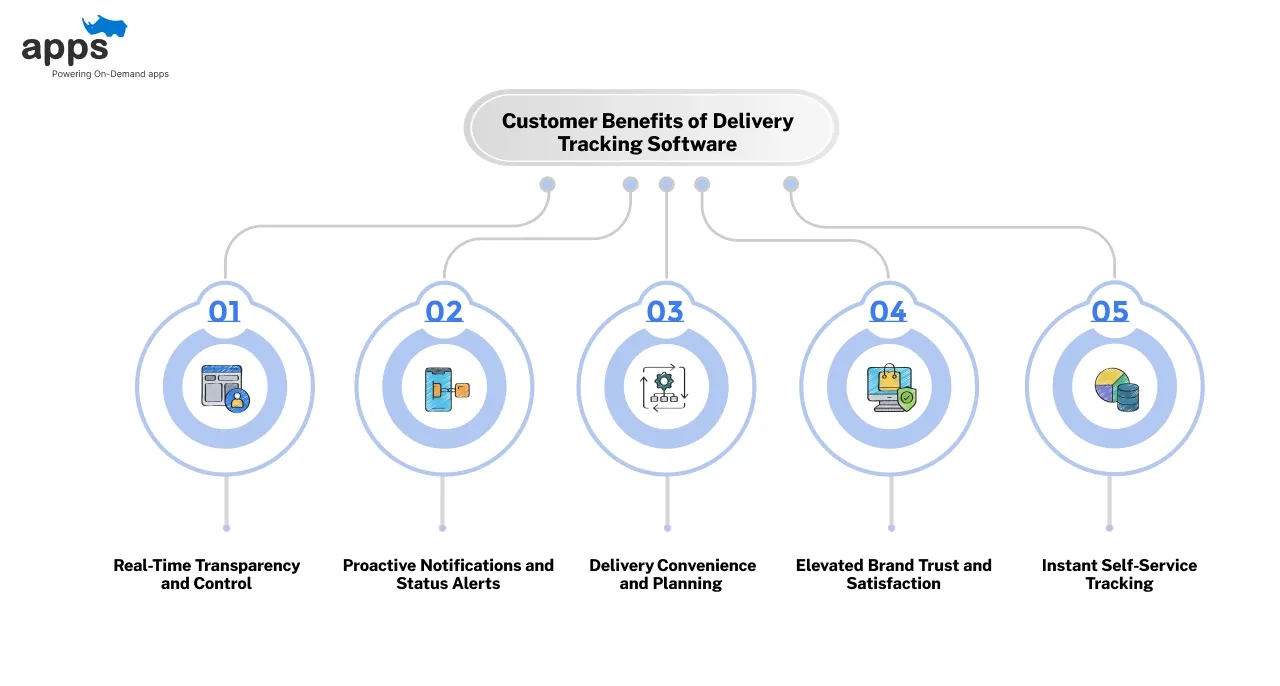
Customers expect transparency and control when ordering online. Delivery tracking software helps meet these expectations by turning order tracking into a value-added buying experience.
1. Real-Time Transparency and Control
With shipment tracking software, customers don’t need to wonder where their order is. They can see location updates and ETAs instantly.
- Provides peace of mind throughout the delivery process
- Turns waiting into a predictable experience
- According to Loqate, 65% of retailers across the UK, the US, and Germany report that late or failed deliveries significantly impact their business.
2. Proactive Notifications and Status Alerts
Delivery tracking software sends customers automated SMS or email updates as their order moves through different journey stages.
- Keeps buyers informed of changes, delays, or delivery confirmations
- Reduces frustration and the need for follow-up emails or calls
- Brands that send proactive updates see fewer negative reviews and more satisfaction.
3. Delivery Convenience and Planning
Customers can plan their schedules around the estimated delivery date and ensure someone is available to receive the package.
- Reduces missed deliveries or failed drop-offs
- Improves the success rate of first-attempt deliveries
- Creates a smoother, more professional experience for high-value or time-sensitive orders
4. Elevated Brand Trust and Satisfaction
When customers can track orders from checkout to doorstep, they perceive the brand as reliable and professional.
- Builds brand equity and confidence through communication
- Reduces buyer anxiety, especially for new or high-ticket customers
- Contributes to stronger Net Promoter Scores (NPS) and retention rates
5. Instant Self-Service Tracking
With delivery tracking software, customers can check on their shipment any time, without contacting support.
- Offers a frictionless post-purchase experience
- Aligns with modern self-service expectations
- Reduces operational costs while improving customer satisfaction
Shipment tracking software is no longer just an internal operations tool. It’s a customer-facing asset that drives loyalty, reduces costs, and keeps businesses competitive.
Suggested Reading:
30 best shipment tracking software- Compared and Reviewed
Common Challenges and Limitations of Shipment Tracking Software
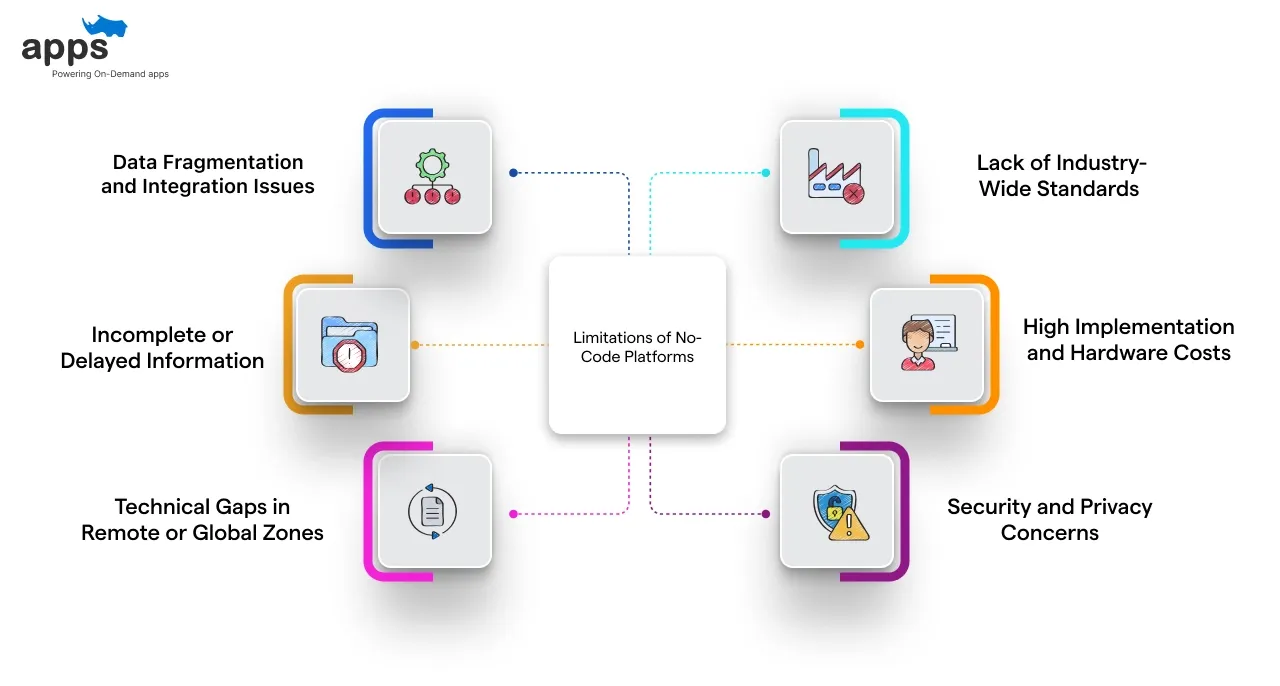
While modern shipment tracking software provides powerful end-to-end visibility, it has limitations.
Even the most advanced delivery tracking software can run into data accuracy, connectivity, and integration issues, especially when coordinating across carriers, borders, and devices.
1. Data Fragmentation and Integration Issues
Many logistics operations struggle to unify tracking data across multiple carriers and freight partners. If your shipment tracking software lacks seamless API integration with regional or international providers, it can lead to blind spots in your visibility.
Customers experience this as partial or delayed updates, while internal teams must juggle multiple tracking dashboards. Failure to integrate with systems like WMS or ERP further fragments your data.
- Solution: Use platforms like AfterShip or EasyPost, which support integration with hundreds of global carriers through unified APIs and allow easy connectivity to existing logistics stacks.
2. Lack of Industry-Wide Standards
There’s no global standard for shipping statuses, scan events, or tracking terminology. This makes it difficult to consolidate data across different regions and shipping providers, especially in international operations.
While initiatives like UN/CEFACT’s Smart Container Data Model are working toward consistency, they haven’t seen widespread adoption yet. Most businesses are left handling data normalization manually or through custom-coded middleware.
- Solution: Opt for delivery tracking software that includes built-in status normalization. This ensures that whether a package is “in transit,” “departed facility,” or “on the way,” the customer sees a clean, consistent update.
3. Incomplete or Delayed Information
One of the most frustrating limitations of shipment tracking is stale data. A package might be moving but hasn’t been scanned in hours, or customs checkpoints and international handoffs may go unreported entirely.
According to a report by FinTech Global, 69% of businesses believe they lack the necessary visibility over their supply chains to protect their reputations. Incomplete tracking leads to more “Where’s my order?” inquiries and lower satisfaction.
- Solution: Use tracking platforms with webhook capabilities and predictive updates. These systems use real-time carrier APIs and historical data modeling to provide proactive ETA adjustments and status corrections when missing scans.
4. High Implementation and Hardware Costs
Sophisticated tracking infrastructure—like GPS-enabled containers or IoT sensors—is expensive to roll out and maintain. This creates a barrier for small and mid-sized businesses looking to compete with more prominent players.
For instance, GPS tracking devices for containers can cost between $75 and $150 each, not including service fees and software integration costs.
- Solution: Start with cloud-based shipment tracking software (SaaS) that delivers strong ROI with minimal hardware investment. As you scale, consider layering IoT for high-value or time-sensitive shipments only.
5. Technical Gaps in Remote or Global Zones
No tracking system is perfect in low-signal environments. Steel shipping containers, remote rural areas, and congested port zones often interfere with real-time updates. When the signal is lost, tracking halts, causing panic for customers and logistics teams.
According to a report by Supply Chain Dive, only 6% of companies report complete visibility on their supply chain.
- Solution: Choose delivery tracking systems that support multi-network devices capable of switching between cellular, Wi-Fi, and satellite signals. Look for software that caches and syncs scan data once connectivity is restored.
6. Security and Privacy Concerns
Live tracking data—especially GPS coordinates and delivery timelines—can become a liability if exposed. Fraudsters could intercept or spoof tracking pages, and overexposure of delivery information may lead to privacy breaches.
For companies in healthcare, defense, or luxury goods, the stakes are even higher. Protecting every touchpoint where shipment data is accessed or shared is critical.
- Solution: Invest in platforms that provide role-based access controls, two-factor authentication, and end-to-end data encryption. Additionally, tokenized tracking links for customer access should ensure that only authorized viewers see sensitive location data.
Quick Reference: Common Limitations & Practical Solutions
To truly unlock the full potential of shipment tracking software, businesses must first understand the real-world roadblocks they may face. Below is a breakdown of common limitations and how advanced delivery tracking software helps overcome them.
Limitation | Solution |
| Data Fragmentation Across Carriers | Use shipment tracking software with built-in APIs + middleware for unified integration. |
| Inconsistent Terminology & Status Codes | Opt for platforms with automated data normalization across global carriers. |
| Missing or Delayed Updates | Enable webhook push notifications and predictive ETA engines to fill gaps. |
| High Upfront Costs for IoT Tracking | Start with SaaS delivery tracking software and scale into hardware upgrades gradually. |
| Remote Area Connectivity Issues | Use multi-network devices with syncing and fallback mechanisms. |
| Security & Privacy Risks | Choose software with role-based access, encryption, and secure token-based tracking links. |
How to Choose the Right Shipment Tracking Software
Selecting the best shipment tracking software (or delivery tracking software) for your needs requires careful consideration of several factors. Here are some steps and tips to guide your decision.
A) Assess Your Needs and Pain Points
Start by identifying what problems you need the tracking software to solve. What are your primary pain points? Are customers complaining about a lack of updates? Are you dealing with lost shipments or inefficient manual processes?
Note if your issues are due to a lack of visibility, customer dissatisfaction from delayed deliveries, or trouble handling shipping exceptions.
Also consider volume (how many shipments you handle daily) and which carriers/modes you use.
B) Match Features to Your Goals (and Budget)
Look for software that offers the features to address your needs. For example, multi-carrier support and customs tracking are essential if you ship internationally.
Make a list of must-have features (real-time map tracking, notifications, integrations, analytics, etc.) and nice-to-haves. Then compare vendors, keeping your budget in mind.
Pricing can vary widely (some charge per shipment, others a flat subscription). Ensure the solution is scalable if your business grows.
C) Check Integration and Ease of Use
The tracking software should mesh well with your existing operations. Verify it can integrate with your order management system, warehouse software, e-commerce platform, or other tools.
A good solution will have APIs or out-of-the-box plugins for popular systems.
Also, evaluate the user interface for your team and customers. It should be intuitive and not require extensive training. Key factors include cost, scalability, integration, and ease of use when evaluating options.
D) Research Vendor Reputation
Do some homework on the providers you’re considering. How reliable is their service (any history of downtime)? Do they update the software regularly with new features and carrier integrations?
Reading reviews on platforms like G2, Capterra, or Clutch can provide insight into absolute user satisfaction.
Look for testimonials or case studies in your industry – e.g., if you’re an online retailer, has the vendor successfully worked with similar retail brands?
E) Take Advantage of Demos or Trials
Most shipment tracking software companies offer a free trial or demo. Use these to see the software in action with your data.
Test the integration with your systems during a trial and try tracking a few actual orders to see how the information flows.
This hands-on approach will show whether the solution meets your expectations and can seamlessly integrate with your operations. It’s also a chance to involve your team (warehouse managers, customer service reps, etc.) to get their feedback on the tool.
Following these steps, you can confidently narrow down the field and choose a tracking solution that fits your business. The right choice will be the one that balances functionality, usability, and cost, and ultimately makes your shipping process more transparent and efficient.
Top Shipment Tracking Software Options in 2025
Many shipment tracking software solutions are on the market (often called delivery tracking software). Below are some of the top options for 2025, spanning various use cases from e-commerce to freight.
A) AfterShip
A popular cloud-based shipment tracking software platform used by e-commerce businesses of all sizes.
- AfterShip integrates with over 1,100 carriers globally, aggregating all your tracking in one place.
- It provides real-time updates and allows you to create branded tracking pages and notifications to engage customers.
- AfterShip offers plans ranging from free (for low shipment volumes) up to enterprise level, making it accessible for startups through to large retailers.
B) Narvar
An enterprise-grade post-purchase experience solution used by major retail brands.
- Narvar’s platform informs customers with configurable tracking pages, personalized notifications, and even feedback collection after delivery.
- It supports tracking across carriers and also handles returns management.
- Big companies choose Narvar for its ability to tailor the experience to their brand and its proven scalability in high-volume environments.
C) parcelLab
A leading shipment tracking software platform for post-purchase operations, known for its robust tracking and communication features.
- parcelLab is a global solution that consolidates tracking information worldwide and lets businesses send proactive updates to customers.
- It was recognized as a global leader in the order tracking category by G2 in 2024. (Source: parcelLab)
- With parcelLab, companies can deeply customize the customer’s tracking journey and gain insights from detailed delivery analytics.
D) project44
A top choice for supply chain and logistics professionals, project44 is a real-time transportation visibility platform.
- It excels at freight and multi-modal shipment tracking (truck, rail, ocean, air), and is often used by manufacturers, distributors, and 3PLs.
- project44’s system handles over 1 billion shipments annually for thousands of global customers.
- It provides live location tracking, predictive ETA analytics, and strong integration into TMS (Transportation Management Systems) and ERP software.
Honorable mentions: Other notable tools include ShipStation (which combines shipping label management with tracking updates), Route (a customer-facing package tracking app for online orders), FourKites and Motive (for enterprise freight visibility), and ParcelPanel (a top-rated tracking app for Shopify merchants).
Each option has strengths, so the “best” choice depends on your needs. It’s wise to compare several providers' features, pricing, and reviews before deciding.
Future of Shipment Tracking
The future of shipment and delivery tracking is poised to be even more real-time, data-driven, and proactive. Emerging technologies are transforming what’s possible in this space.
- For instance, the Internet of Things (IoT) enables a world where virtually every package or pallet can carry a clever sensor, broadcasting location and reporting conditions like temperature or shock. This granular visibility is vital for industries like pharmaceuticals and food, and it’s becoming more accessible across the board.
- AI and machine learning are also playing a growing role. They are being used to predict delays (by analyzing weather, traffic, and historical data) and to recommend optimal shipping routes or contingency plans.
In short, tracking systems will increasingly not just report where a shipment is, but also anticipate where it should be and flag potential issues before they happen.
- We’re also moving toward a future of total supply chain transparency. Companies will have unprecedented control over shipments and can intervene at any transit point.
- Customers, meanwhile, will enjoy more interactive and precise tracking – imagine live maps showing the delivery vehicle approaching their address, or getting voice-assistant updates (“Alexa, where’s my package?”).
- Blockchain is being explored to create tamper-proof tracking records for higher security and trust. In the coming years, expect shipment tracking to be faster, more precise, and deeply integrated with every part of the supply chain, from warehouse management to last-mile delivery.
Businesses that embrace these advances will be able to deliver a smoother, more reliable experience, delivering on customer expectations with agility and confidence.
Final Thoughts: Why Shipment Tracking Software Is No Longer Optional
Shipment tracking software has evolved from a convenience into a critical logistics and customer experience tool. It empowers businesses with real-time visibility, operational efficiency, and the ability to meet rising consumer expectations for transparency.
Throughout this guide, we’ve covered how delivery tracking software works, its benefits, and how to navigate implementation challenges.
In today’s fast-moving digital economy, shipment tracking software bridges operational excellence and customer trust. Whether you're managing eCommerce deliveries, B2B shipments, or third-party logistics, choosing the right platform is essential for staying competitive.
For a tailored solution, AppsRhino offers custom logistics and delivery app development. Their team builds scalable, real-time tracking tools to meet your unique business needs. As order volumes grow and expectations soar, now is the time to invest in a solution that keeps your supply chain strong and your customers informed.
Frequently Asked Questions (FAQs)
What industries benefit most from shipment tracking software?
Shipment tracking software benefits industries like eCommerce, pharmaceuticals, manufacturing, and food delivery by providing real-time visibility, reducing delays, and improving customer satisfaction across complex logistics chains.
Can shipment tracking software work with international carriers?
Yes, many shipment tracking software platforms integrate with global carriers and normalize international tracking codes, offering real-time updates, customs status, and multilingual support for cross-border shipping operations.
How does shipment tracking software support return management?
Advanced shipment tracking software often includes return tracking tools that simplify reverse logistics, offer customer visibility on return shipments, and optimize refund processing through real-time package updates.
Is shipment tracking software suitable for small businesses?
Absolutely. Lightweight, affordable shipment tracking software offers essential features like multi-carrier tracking, branded pages, and alerts, helping small businesses compete without heavy tech investment.
How secure is shipment tracking software?
Modern shipment tracking software includes features like encrypted URLs, two-factor authentication, and role-based access to ensure delivery data privacy and protect real-time location tracking from unauthorized access.
Does shipment tracking software help with carbon footprint reduction?
Yes, some shipment tracking software tools include carbon tracking modules that analyze transportation routes and suggest optimizations, helping reduce emissions and support greener logistics initiatives.
Table of Contents
- Introduction
- What is Shipment Tracking Software?
- Key Features of Shipment Tracking Software
- How Shipment Tracking Software Works
- Types of Shipment Tracking Software
- Benefits of Shipment Tracking Software
- Common Challenges and Limitations of Shipment Tracking Software
- Quick Reference: Common Limitations & Practical Solutions
- How to Choose the Right Shipment Tracking Software
- Top Shipment Tracking Software Options in 2025
- Future of Shipment Tracking
- Final Thoughts: Why Shipment Tracking Software Is No Longer Optional
- Frequently Asked Questions (FAQs)


